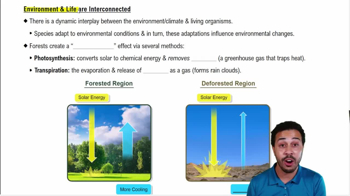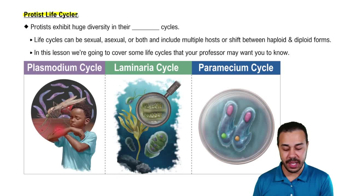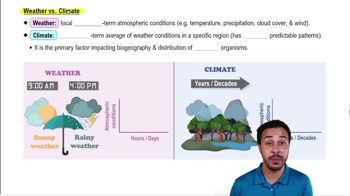Table of contents
- 1. Introduction to Biology2h 42m
- 2. Chemistry3h 37m
- 3. Water1h 26m
- 4. Biomolecules2h 23m
- 5. Cell Components2h 26m
- 6. The Membrane2h 31m
- 7. Energy and Metabolism2h 0m
- 8. Respiration2h 40m
- 9. Photosynthesis2h 49m
- 10. Cell Signaling59m
- 11. Cell Division2h 47m
- 12. Meiosis2h 0m
- 13. Mendelian Genetics4h 44m
- Introduction to Mendel's Experiments7m
- Genotype vs. Phenotype17m
- Punnett Squares13m
- Mendel's Experiments26m
- Mendel's Laws18m
- Monohybrid Crosses19m
- Test Crosses14m
- Dihybrid Crosses20m
- Punnett Square Probability26m
- Incomplete Dominance vs. Codominance20m
- Epistasis7m
- Non-Mendelian Genetics12m
- Pedigrees6m
- Autosomal Inheritance21m
- Sex-Linked Inheritance43m
- X-Inactivation9m
- 14. DNA Synthesis2h 27m
- 15. Gene Expression3h 6m
- 16. Regulation of Expression3h 31m
- Introduction to Regulation of Gene Expression13m
- Prokaryotic Gene Regulation via Operons27m
- The Lac Operon21m
- Glucose's Impact on Lac Operon25m
- The Trp Operon20m
- Review of the Lac Operon & Trp Operon11m
- Introduction to Eukaryotic Gene Regulation9m
- Eukaryotic Chromatin Modifications16m
- Eukaryotic Transcriptional Control22m
- Eukaryotic Post-Transcriptional Regulation28m
- Eukaryotic Post-Translational Regulation13m
- 17. Viruses37m
- 18. Biotechnology2h 58m
- 19. Genomics17m
- 20. Development1h 5m
- 21. Evolution3h 1m
- 22. Evolution of Populations3h 53m
- 23. Speciation1h 37m
- 24. History of Life on Earth2h 6m
- 25. Phylogeny2h 31m
- 26. Prokaryotes4h 59m
- 27. Protists1h 12m
- 28. Plants1h 22m
- 29. Fungi36m
- 30. Overview of Animals34m
- 31. Invertebrates1h 2m
- 32. Vertebrates50m
- 33. Plant Anatomy1h 3m
- 34. Vascular Plant Transport1h 2m
- 35. Soil37m
- 36. Plant Reproduction47m
- 37. Plant Sensation and Response1h 9m
- 38. Animal Form and Function1h 19m
- 39. Digestive System1h 10m
- 40. Circulatory System1h 49m
- 41. Immune System1h 12m
- 42. Osmoregulation and Excretion50m
- 43. Endocrine System1h 4m
- 44. Animal Reproduction1h 2m
- 45. Nervous System1h 55m
- 46. Sensory Systems46m
- 47. Muscle Systems23m
- 48. Ecology3h 11m
- Introduction to Ecology20m
- Biogeography14m
- Earth's Climate Patterns50m
- Introduction to Terrestrial Biomes10m
- Terrestrial Biomes: Near Equator13m
- Terrestrial Biomes: Temperate Regions10m
- Terrestrial Biomes: Northern Regions15m
- Introduction to Aquatic Biomes27m
- Freshwater Aquatic Biomes14m
- Marine Aquatic Biomes13m
- 49. Animal Behavior28m
- 50. Population Ecology3h 41m
- Introduction to Population Ecology28m
- Population Sampling Methods23m
- Life History12m
- Population Demography17m
- Factors Limiting Population Growth14m
- Introduction to Population Growth Models22m
- Linear Population Growth6m
- Exponential Population Growth29m
- Logistic Population Growth32m
- r/K Selection10m
- The Human Population22m
- 51. Community Ecology2h 46m
- Introduction to Community Ecology2m
- Introduction to Community Interactions9m
- Community Interactions: Competition (-/-)38m
- Community Interactions: Exploitation (+/-)23m
- Community Interactions: Mutualism (+/+) & Commensalism (+/0)9m
- Community Structure35m
- Community Dynamics26m
- Geographic Impact on Communities21m
- 52. Ecosystems2h 36m
- 53. Conservation Biology24m
28. Plants
Land Plants
Problem 2
Textbook Question
Identify the cloud seen in each photograph. Describe the life cycle events associated with each cloud.
<Image>
 Verified step by step guidance
Verified step by step guidance1
Analyze the first photograph (a): The cloud seen in the image is pollen being released from the pine tree, which is a gymnosperm. Pollen grains are male gametophytes that are dispersed by wind to reach female cones for fertilization.
Describe the life cycle events associated with the pine tree: Gymnosperms reproduce through alternation of generations. The mature sporophyte (pine tree) produces male cones that release pollen and female cones that contain ovules. Fertilization occurs when pollen reaches the ovule, leading to the development of seeds.
Analyze the second photograph (b): The cloud seen in the image is spores being released from the puffball fungus, which is a club fungus. Spores are reproductive units that are dispersed by wind or other mechanisms to germinate and form new fungal structures.
Describe the life cycle events associated with the puffball fungus: Club fungi reproduce sexually through the production of basidiospores. The mature fruiting body (puffball) releases spores, which germinate under favorable conditions to form hyphae. Hyphae from different mating types fuse to form a dikaryotic mycelium, eventually leading to the formation of new fruiting bodies.
Compare the reproductive strategies: Both the pine tree and puffball fungus rely on dispersal mechanisms (wind) to spread their reproductive units (pollen and spores, respectively). However, gymnosperms produce seeds for reproduction, while fungi produce spores that germinate directly into new organisms.
 Verified video answer for a similar problem:
Verified video answer for a similar problem:This video solution was recommended by our tutors as helpful for the problem above
Video duration:
1mPlay a video:
Was this helpful?
Key Concepts
Here are the essential concepts you must grasp in order to answer the question correctly.
Cloud Classification
Clouds are classified into various types based on their appearance and altitude, including cirrus, cumulus, stratus, and nimbus. Each type has distinct characteristics that indicate different weather patterns and atmospheric conditions. Understanding these classifications is essential for identifying clouds in photographs and predicting associated weather events.
Recommended video:
Guided course

Environment & Life are Interconnected
Cloud Life Cycle
The life cycle of clouds involves several stages, including formation, growth, and dissipation. Clouds form when water vapor in the atmosphere cools and condenses into tiny droplets or ice crystals. The life cycle can be influenced by factors such as temperature, humidity, and atmospheric pressure, which determine how long a cloud persists and its potential to produce precipitation.
Recommended video:
Guided course

Protist Life Cycles
Weather Patterns and Phenomena
Clouds play a crucial role in weather patterns and phenomena, influencing precipitation, storms, and climate. Different cloud types are associated with specific weather events; for example, cumulonimbus clouds are linked to thunderstorms, while stratus clouds often bring overcast skies and light rain. Recognizing these associations helps in understanding the broader implications of cloud types on weather forecasting.
Recommended video:
Guided course

Weather vs. Climate
Related Videos
Related Practice
Textbook Question
In this abbreviated diagram, identify the four major plant groups and the key terrestrial adaptation associated with each of the three major branch points.
1117
views


